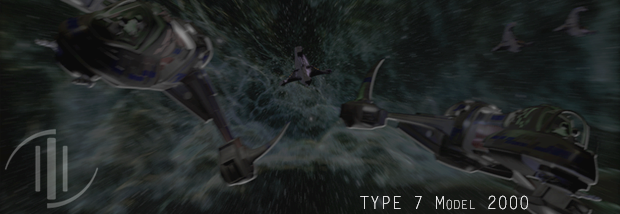The Type 7 is the poster boy of the Tears of the Stars universe. No wonder – it does, after all, grace the cover of Grieving Suns. As the ‘cool ship’ of the universe a whole lot more thought went into the design and specifications under the hood of the Type 7.
In the universe
In the mid- to late 1980’s, after the discovery of Altspace and the creation of the first practical Ensquare drives derived from this discovery, the number of suddenly viable ship types exploded. The fleets own engineers as well as several aerospace companies (most notable among them the little known Australia-based Cirian Aeronautics Corporation – CAC) went to work designing the first generation of space-based small and medium craft. While basic fighter and bomber designs were quickly nailed down, the fleet quickly realized that focusing on space combat alone would limit the viability of its vessels in situations where atmospheres are involved. The requirements for the Type 7 were subsequently altered from a soley spacegoing design to allow for atmospheric flight and to act as ground support craft – or a fighter-bomber.
The model 2000
Currently the most common model of the Type 7 (with a few remnant model 1989’s relegated to training duties, and the model 2000 itself slowly being replaced by the thoroughly updated model 2011), it has become the iconic mainstay of Earth fleet. Clocking in at around 24.000kg dry mass, it is decidedly on the heftier side of small craft in Earths’ arsenal, earning it the somewhat disparaging nickname ‘Whale’. It isn’t the smallest, either, at 20 meters in length, a quarter of which is taken up by the cockpit area, and another quarter by the large, ribbed neck doubling as a heatsink.
The fighter is typically operated by a two-person crew, divided into the pilot and operator jobs. The pilot seat is the aft one, slightly elevated above the operator for enhanced visibility. Technically both stations are fully functional in either role to ensure the continued operation of a Type 7 in the event of severe damage to one, or situations where one of the crew is incapacitated (or the craft being flown by a single pilot).
Like much of the fleet it is powered by a small variable output Thorium fuel nuclear reactor with a peak output of approximately 440 kilowatts of electrical energy. This relatively powerful reactor combined with the comparatively small size of the fighter limits the endurance of the craft. The heat sinks typically reach capacity within 36 hours of the commencing of operations – or a much shorter 11 hours in combat situations.
The limits on Altspace travel are even more restrictive – the high power output required to open an Altspace rift and maintain FTL speeds mean an effective maximum round-trip distance (there and back again) of only a quarter to half a lightyear before the ship is threatened with thermal shutdown and requires immediate external cooling.
Due to the high mass maneouvrability is more limited than that of other ships its size – its Ensquares enable it to sustain acceleration in the 4G range before Altspace effects begin to emerge around the craft. The atmospheric engines also have small tanks of rocket fuel attached to them which allow a Model 2000 to gain a short burst of extra acceleration by burning this fuel.
These drawbacks are balanced by the excellent survivability of the craft and the protection it offers its occupants. Its shield system can generate one of the strongest shield fields for a ship of its size and can take a severe beating before becoming saturated. And even with shields gone the craft is covered in state of the art ablative armour, covering all but the more exposed heat sinks and radiators. The cockpit cupola is made of layered aluminium compounds and highly resistant to impacts of all kinds – a necessity both in combat and even normal flight operations where micro-meteroites may pose a threat to limb and life otherwise.
Model 2000s’ are outfitted with four 30mm caliber mass driver cannons mounted in the top side of the wings; Additionally there is a ‘chin’ turret mounted under the cockpit section with twin 20m mass drivers. This turret is removable and can be replaced by mission-specific equipment – such as a reconnaissance sensor package or left empty to reduce mass.
The missile armament consists of up to ten small shatterhead missiles, or six larger ones – or a mix thereof – in two racks mounted to the lower side of the wings. The missiles are carried internally in a revolving magazine, only exposing two missiles at the time (port and starboard) to the launch tubes.
Unique among the fighter craft of the fleet is the variable geometry shield system and the electric-powered atmospheric engines mounted to the wing tips. These allow the craft to operate within atmospheres – the variable geometry of the shield field allows for extra lift to be generated when necessary, as well as providing a larger surface area for re-entry procedures. It also allows the fighter to switch into a high-speed travel mode, enabling it to travel at several times the speed of sound in the local atmosphere.
Model 2000s are most prominently used by the Blue Lions throughout 2015.
Specifications |
|
|---|---|
| Name | Type 7 Endo-/Exo-Atmospheric fighter – Model 2000 |
| Dimensions | Length: 20m / Beam: 18m /Height: 5.3m |
| Dry Mass | 23.986kg |
| Max. Takeoff weight | 34.100kg |
| Powerplant | CAC-440 Thorium MSR, 440kW electric |
| Engines | Space: 10x 400kN Ensquares (2 front, 2 aft, 1 port, 1 starboard, 2 dorsal, 2 ventral) Atmosphere: 2x75kN CAC electric jets |
| Max. Speed | 955 km/h / up to 6.500 km/h with appropriate shield geometry |
